Mineralogical Characteristics of Late Permian Coals from the Yueliangtian Coal Mine, Guizhou, Southwestern China
Abstract
:1. Introduction
2. Geological Setting
3. Sample Collection and Analytical Procedures
4. Result
4.1. Coal Chemistry and Vitrinite Reflectance
4.2. Minerals in the No. 6 Coals in the Yueliangtian Coal Mine
4.2.1. Minerals in Coal Benches
4.2.2. Minerals in the Partings
5. Discussion
5.1. Sediment-Source Region Influence
5.2. Multi-Stage Injections of Hydrothermal Fluids
5.3. Seawater Influence
5.4. Volcanic Ash Input
6. Conclusions
- (1)
- The major mineral phases in the YLT6U and YLT6L coals are calcite, quartz, kaolinite and pyrite and, to a lesser extent, chlorite, anatase, illite, mixed-layer illite/smectite, rutile, bassanite and ankerite. The Emeishan basalt and silicic rocks in the Kangdian Upland are the parent rocks of the Yueliangtian coals.
- (2)
- Different modes of occurrence of chamosite are present in the YLT6 coal. This, accompanied with cell-filling quartz, pyrite, and calcite veins, suggests that multi-stage hydrothermal fluids influenced the Yueliangtian coals.
- (3)
- The sedimentary environment is different between the YLT6U and YLT6L coals. Seawater had a tremendous influence on the YLT6L coal and terminated at the YLT6U-9p sampling interval.
- (4)
- Three tonstein (samples YLT6U-2p, YLT6U-9p and YLT6L-4p) layers identified in the coal are probably derived from felsic volcanic ash. These tonsteins are characterized by the occurrence of vermicular kaolinite and chloritized biotite. The roof strata of the YLT6L coal also appear to have been derived from felsic volcanic ash.
Acknowledgments
Author Contributions
Conflicts of Interest
References
- Dai, S.F.; Ren, D.Y.; Chou, C.-L.; Finkelman, R.B.; Seredin, V.V.; Zhou, Y.P. Geochemistry of trace elements in Chinese coals: A review of abundances, genetic types, impacts on human health, and industrial utilization. Int. J. Coal Geol. 2012, 94, 3–21. [Google Scholar] [CrossRef]
- Liu, J.J.; Yang, Z.; Yan, X.Y.; Ji, D.P.; Yang, Y.C.; Hu, L.C. Modes of occurrence of highly-elevated trace elements in superhigh-organic-sulfur coals. Fuel 2015, 156, 190–197. [Google Scholar] [CrossRef]
- Dai, S.F.; Ren, D.Y.; Zhou, Y.P.; Chou, C.-L.; Wang, X.B.; Zhao, L.; Zhu, X.W. Mineralogy and geochemistry of a superhigh-organic-sulfur coal, Yanshan Coalfield, Yunnan, China: Evidence for a volcanic ash component and influence by submarine exhalation. Chem. Geol. 2008, 255, 182–194. [Google Scholar] [CrossRef]
- Shao, Y.B.; Guo, Y.H.; Qin, Y.; Shen, Y.L.; Tian, L. Distribution characteristic and geological significance of rare earth elements in Lopingian mudstone of Permian, Panxian county, Guizhou province. Min. Sci. Technol. 2011, 21, 469–476. [Google Scholar] [CrossRef]
- Zhang, J.Y.; Ren, D.Y.; Zheng, C.G.; Zeng, R.S.; Chou, C.-L.; Liu, J. Trace element abundances in major minerals of Late Permian coals from southwestern Guizhou province, China. Int. J. Coal Geol. 2002, 53, 55–64. [Google Scholar] [CrossRef]
- Xiao, K. Analysia of principles for geological structures of Yueliangtian Coal Mine. Min. Saf. Environ. Prot. 2003, 30, 25–26. [Google Scholar]
- Dai, S.F.; Chekryzhov, I.Y.; Seredin, V.V.; Nechaev, V.P.; Graham, I.T.; Hower, J.C.; Ward, C.R.; Ren, D.Y.; Wang, X.B. Metalliferous coal deposits in East Asia (Primorye of Russia and South China): A review of geodynamic controls and styles of mineralization. Gondwana Res. 2016, 29, 60–82. [Google Scholar] [CrossRef]
- Dai, S.F.; Seredin, V.V.; Ward, C.R.; Hower, J.C.; Xing, Y.W.; Zhang, W.G.; Song, W.J.; Wang, P.P. Enrichment of U-Se-Mo-Re-V in coals preserved within marine carbonate successions: Geochemical and mineralogical data from the Late Permian Guiding Coalfield, Guizhou, China. Miner. Deposita 2015, 50, 159–186. [Google Scholar] [CrossRef]
- Ward, C.R. Analysis and significance of mineral matter in coal seams. Int. J. Coal Geol. 2002, 50, 135–168. [Google Scholar] [CrossRef]
- Yuan, M.; Zhang, F. Structure formation and its application to coal exploration in south No. 4 Mining Field, Yueliangtian Coal Mine. Coal Geol. Explor. 2004, 4, 16–18. [Google Scholar]
- Coal Geology Bureau of China. Sedimentary Environments and Coal Accumulation of Late Permian Coal Formation in Western Guizhou, Southern Sichuan and Eastern Yunnan, China; Chongqing University Press: Chongqing, China, 1996. (In Chinese) [Google Scholar]
- Dai, S.F.; Ren, D.Y.; Tang, Y.G.; Shao, L.Y.; Hao, L.M. Influences of low-temperature hydrothermal fluid on the re-distributions and occurrences of associated elements in coal—A case study from the Late Permian coals in the Zhijin Coalfield, Guizhou Province, southern China. Acta Geol. Sin. 2002, 76, 437–445. [Google Scholar]
- Dai, S.F.; Ren, D.Y.; Tang, Y.G.; Yue, M.; Hao, L.M. Concentration and distribution of elements in Late Permian coals from western Guizhou Province, China. Int. J. Coal Geol. 2005, 61, 119–137. [Google Scholar] [CrossRef]
- Dai, S.F.; Chou, C.-L.; Yue, M.; Luo, K.L.; Ren, D.Y. Mineralogy and geochemistry of a Late Permian coal in the Dafang Coalfield, Guizhou, China: Influence from siliceous and iron-rich calcic hydrothermal fluids. Int. J. Coal Geol. 2005, 61, 241–258. [Google Scholar] [CrossRef]
- Dai, S.F.; Li, T.; Seredin, V.V.; Ward, R.C.; Hower, J.C.; Zhou, Y.P.; Zhang, M.Q.; Song, X.L.; Song, W.J.; Zhao, C.L. Origin of minerals and elements in the Late Permian coals, tonsteins, and host rocks of the Xinde Mine, Xuanwei, eastern Yunnan, China. Int. J. Coal Geol. 2014, 121, 53–78. [Google Scholar] [CrossRef]
- Coal Analysis Laboratory of China Coal Research Institute. Chinese Standard Method GB/T 482-2008, Sampling of Coal Seams; National Coal Standardization Technical Committee: Beijing, China, 2008. [Google Scholar]
- ASTM International. Test Method for Moisture in the Analysis Sample of Coal and Coke; ASTM D3173-11; ASTM International: West Conshohocken, PA, USA, 2011. [Google Scholar]
- ASTM International. Test Method for Volatile Matter in the Analysis Sample of Coal and Coke; ASTM D3175-11; ASTM International: West Conshohocken, PA, USA, 2011. [Google Scholar]
- ASTM International. Test Method for Ash in the Analysis Sample of Coal and Coke from Coal; ASTM D3174-11; ASTM International: West Conshohocken, PA, USA, 2011. [Google Scholar]
- ASTM International. Test Methods for Total Sulfur in the Analysis Sample of Coal and Coke; ASTM D3177-02; ASTM International: West Conshohocken, PA, USA, 2011. [Google Scholar]
- ASTM International. Standard Practice for Preparing Coal Samples for Microscopical Analysis by Reflected Light; ASTM Standard D2797/D2797M-11a; ASTM International: West Conshohocken, PA, USA, 2011. [Google Scholar]
- ASTM International. Standard Test Method for Microscopical Determination of the Vitrinite Reflectance of Coal; ASTM Standard D2798-11a; ASTM International: West Conshohocken, PA, USA, 2011. [Google Scholar]
- Rietveld, H.M. A profile refinement method for nuclear and magnetic structures. J. Appl. Crystal. 1969, 2, 65–71. [Google Scholar] [CrossRef]
- Taylor, J.C. Computer programs for standardless quantitative analysis of minerals using the full powder diffraction profile. Powder Diffr. 1991, 6, 2–9. [Google Scholar] [CrossRef]
- Ward, C.R.; Spears, D.A.; Booth, C.A.; Staton, I.; Gurba, L.W. Mineral matter and trace elements in coals of the Gunnedah Basin, New South Wales, Australia. Int. J. Coal Geol. 1999, 40, 281–308. [Google Scholar] [CrossRef]
- Ward, C.R.; Matulis, C.E.; Taylor, J.C.; Dale, L.S. Quantification of mineral matter in the Argonne Premium coals using interactive Rietveld-based X-ray diffraction. Int. J. Coal Geol. 2001, 46, 67–82. [Google Scholar] [CrossRef]
- Ruan, C.D.; Ward, C.R. Quantitative X-ray powder diffraction analysis of clay minerals in Australian coals using Rietveld methods. Appl. Clay Sci. 2002, 21, 227–240. [Google Scholar] [CrossRef]
- Dai, S.F.; Yang, J.Y.; Ward, C.R.; Hower, J.C.; Liu, H.D.; Garrison, T.M.; French, D.; O’Keefe, J.M.K. Geochemical and mineralogical evidence for a coal-hosted uranium deposit in the Yili Basin, Xinjiang, northwestern China. Ore Geol Rev. 2015, 70, 1–30. [Google Scholar] [CrossRef]
- Dai, S.F.; Wang, P.P.; Ward, C.R.; Tang, Y.G.; Song, X.L.; Jiang, J.H.; Hower, J.C.; Li, T.; Seredin, V.V.; Wagner, N.J.; et al. Elemental and mineralogical anomalies in the coal-hosted Ge ore deposit of Lincang, Yunnan, southwestern China: Key role of N2-CO2-mixed hydrothermal solutions. Int. J. Coal Geol. 2014, 152, 19–46. [Google Scholar] [CrossRef]
- Dai, S.F.; Zhang, W.G.; Ward, C.R.; Seredin, V.V.; Hower, J.C.; Li, X.; Song, W.J.; Wang, X.B.; Kang, H.; Zheng, L.C.; et al. Mineralogical and geochemical anomalies of late Permian coals from the Fusui Coalfield, Guangxi province, southern China: Influences of terrigenous materials and hydrothermal fluids. Int. J. Coal Geol. 2013, 105, 60–84. [Google Scholar] [CrossRef]
- China Southwest Oil and Gas Field Company Exploration and Development Institute. Chinese Petrol and Naturl Gas Industry Standard SY/T 5163-2010, Analysis Method for Clay Minerals and Ordinary Non-Clay Minerals in Sedimentary Rocks by the X-ray Diffraction; Petroleum Exploration Standardization Technical Committee: Beijing, China, 2010. (In Chinese) [Google Scholar]
- ASTM International. Standard Classification of Coals by Rank; ASTM D388-12; ASTM International: West Conshohocken, PA, USA, 2012. [Google Scholar]
- Coal Analysis Laboratory of China Coal Research Institute. Chinese Standard Method GB/T 15224.1-2010, Classification for Quality of Coal. Part 1: Ash; Standardization Administration of China: Beijing, China, 2010. (In Chinese) [Google Scholar]
- Dai, S.F.; Ren, D.Y.; Hou, X.Q.; Shao, L.Y. Geochemical and mineralogical anomalies of the late Permian coal in the Zhijin coalfield of southwest China and their volcanic origin. Int. J. Coal Geol. 2003, 55, 117–138. [Google Scholar] [CrossRef]
- Dai, S.F.; Li, D.H.; Ren, D.Y.; Tang, Y.G.; Shao, L.Y.; Song, H.B. Geochemistry of the late Permian No. 30 coal seam, Zhijin Coalfield of Southwest China: Influence of a siliceous low-temperature hydrothermal fluid. Appl. Geochem. 2004, 19, 1315–1330. [Google Scholar] [CrossRef]
- Zhuang, X.G.; Querol, X.; Zeng, R.S.; Xu, W.D.; Alastuy, A.; Lopez-Soler, A.; Plana, F. Mineralogy and geochemistry of coal from the Liupanshui mining district, Guizhou, south China. Int. J. Coal Geol. 2000, 45, 21–37. [Google Scholar] [CrossRef]
- Dai, S.F.; Wang, X.B.; Chen, W.M.; Li, D.H.; Chou, C.-L.; Zhou, Y.P.; Zhu, C.S.; Li, H.; Zhu, X.Y.; Xing, Y.W.; et al. A high-pyrite semianthracite of late Permian age in the Songzao Coalfield, southwestern China: Mineralogical and geochemical relations with underlying mafic tuffs. Int. J. Coal Geol. 2010, 83, 430–445. [Google Scholar] [CrossRef]
- Widodo, S.; Oschmann, W.; Bechtel, A.; Sachsenhofer, R.F.; Anggayana, K.; Puettmann, W. Distribution of sulfur and pyrite in coal seams from Kutai Basin (east Kalimantan, Indonesia): Implications for paleoenvironmental conditions. Int. J. Coal Geol. 2010, 81, 151–162. [Google Scholar] [CrossRef]
- Dai, S.F.; Hou, X.Q.; Ren, D.Y.; Tang, Y.G. Surface analysis of pyrite in the No. 9 coal seam, Wuda coalfield, Inner Mongolia, China, using high-resolution time-of-flight secondary ion mass-spectrometry. Int. J. Coal Geol. 2003, 55, 139–150. [Google Scholar] [CrossRef]
- Dai, S.F.; Ren, D.Y.; Tang, Y.G.; Shao, L.Y.; Li, S.S. Distribution, isotopic variation and origin of sulfur in coals in the Wuda coalfield, Inner Mongolia, China. Int. J. Coal Geol. 2002, 52, 237–250. [Google Scholar] [CrossRef]
- Yang, J.Y. Modes of occurrence and origins of noble metals in the Late Permian coals from the Puan Coalfield, Guizhou, southwest China. Fuel 2006, 85, 1679–1684. [Google Scholar] [CrossRef]
- Chou, C.-L. Sulfur in coals: A review of geochemistry and origins. Int. J. Coal Geol. 2012, 100, 1–13. [Google Scholar] [CrossRef]
- Zhao, L.; Ward, C.R.; French, D.; Graham, I.T. Mineralogical composition of Late Permian coal seams in the Songzao Coalfield, southwestern China. Int. J. Coal Geol. 2013, 116–117, 208–226. [Google Scholar] [CrossRef]
- Dai, S.F.; Tian, L.W.; Chou, C.-L.; Zhou, Y.; Zhang, M.Q.; Zhao, L.; Wang, J.M.; Yang, Z.; Cao, H.Z.; Ren, D.Y. Mineralogical and compositional characteristics of Late Permian coals from an area of high lung cancer rate in Xuan Wei, Yunnan, China: Occurrence and origin of quartz and chamosite. Int. J. Coal Geol. 2008, 76, 318–327. [Google Scholar] [CrossRef]
- Dai, S.F.; Zhou, Y.P.; Ren, D.Y.; Wang, X.B.; Li, D.; Zhao, L. Geochemistry and mineralogy of the Late Permian coals from the Songzo Coalfield, Chongqing, southwestern China. Sci China Ser. D Earth Sci. 2007, 50, 678–688. [Google Scholar] [CrossRef]
- Dai, S.F.; Liu, J.J.; Ward, C.R.; Hower, J.C.; French, D.; Jia, S.H.; Hood, M.M.; Garrison, T.M. Mineralogical and geochemical compositions of Late Permian coals and host rocks from the Guxu coalfield, Sichuan Province, China, with emphasis on enrichment of rare metals. Int. J. Coal Geol. 2015. [Google Scholar] [CrossRef]
- Wang, X.B.; Wang, R.X.; Wei, Q.; Wang, P.P.; Wei, J.P. Mineralogical and geochemical characteristics of Late Permian coals from the Mahe Mine, Zhaotong Coalfield, Northeastern Yunnan, China. Mineral 2015, 5, 380–396. [Google Scholar] [CrossRef]
- Ren, D.Y. Mineral matter in coal. In Coal Petrology of China; Han, D.X., Ed.; Publishing House of China University of Mining and Technology: Xuzhou, China, 1996; pp. 67–78. (In Chinese) [Google Scholar]
- Xu, Y.G.; Chung, S.L.; Jahn, B.M.; Wu, G.Y. Petrologic and geochemical constraints on the petrogenesis of Permian-Triassic Emeishan flood basalts in southwestern China. Lithos 2001, 58, 145–168. [Google Scholar] [CrossRef]
- Permana, A.K.; Ward, C.R.; Li, Z.; Gurba, L.W. Distribution and origin of minerals in high-rank coals of the South Walker Creek area, Bowen Basin, Australia. Int. J. Coal Geol. 2013, 116–117, 185–207. [Google Scholar] [CrossRef]
- Dai, S.F.; Chou, C.-L. Occurrence and origin of minerals in a chamosite-bearing coal of Late Permian age, Zhaotong, Yunnan, China. Am. Mineral. 2007, 92, 1253–1261. [Google Scholar] [CrossRef]
- Boles, J.R.; Franks, S.G. Clay diagenesis in Wilcox sandstones of southwest Texas: Implications of smectite diagenesis on sandstone cementation. J. Sediment. Res. 1979, 49, 55–70. [Google Scholar]
- Iijima, A.; Matsumoto, R. Berthierine and chamosite in coal measures of Japan. Clay Clay Miner. 1982, 30, 264–274. [Google Scholar] [CrossRef]
- Wang, X.B.; Dai, S.F.; Chou, C.-L.; Zhang, M.Q.; Wang, J.M.; Song, X.L.; Wang, W.; Jiang, Y.F.; Zhou, Y.P.; Ren, D.Y. Mineralogy and geochemistry of Late Permian coals from the Taoshuping Mine, Yunnan Province, China: Evidences for the sources of minerals. Int. J. Coal Geol. 2012, 96–97, 49–59. [Google Scholar] [CrossRef]
- Kolker, A.; Chou, C.-L. Cleat-filling calcite in Illinois Basin coals: Trace element evidence for meteoric fluid migration in a coal basin. J. Geol. 1994, 102, 111–116. [Google Scholar] [CrossRef]
- Spears, D.A.; Kanaris-Sotiriou, R. A geochemical and mineralogical investigation of some British and other European tonsteins. Sedimentology 1979, 26, 407–425. [Google Scholar] [CrossRef]
- Spears, D.A. The origin of tonsteins, an overview, and links with seatearths, fireclays and fragmental clay rocks. Int. J. Coal Geol. 2012, 94, 22–31. [Google Scholar] [CrossRef]
- Dai, S.F.; Luo, Y.B.; Seredin, V.V.; Ward, C.R.; Hower, J.C.; Zhao, L.; Liu, S.D.; Zhao, C.L.; Tian, H.M.; Zou, J.H. Revisiting the Late Permian coal from the Huayingshan, Sichuan, southwestern China: Enrichment and occurrence modes of minerals and trace elements. Int. J. Coal Geol. 2014, 122, 110–128. [Google Scholar] [CrossRef]
- Dai, S.F.; Wang, X.B.; Zhou, Y.P.; Hower, J.C.; Li, D.H.; Chen, W.M.; Zhu, X.W.; Zou, J.H. Chemical and mineralogical compositions of silicic, mafic, and alkali tonsteins in the Late Permian coals from the Songzao Coalfield, Chongqing, Southwest China. Chem. Geol. 2011, 282, 29–44. [Google Scholar] [CrossRef]
- Zhou, Y.P.; Bohor, B.F.; Ren, Y. Trace element geochemistry of altered volcanic ash layers (tonsteins) in Late Permian coal-bearing formations of eastern Yunnan and western Guizhou Provinces, China. Int. J. Coal Geol. 2000, 44, 305–324. [Google Scholar] [CrossRef]
- Bohor, B.F.; Triplehorn, D.M. Tonsteins: Altered volcanic-ash layers in coal-bearing sequences. Geol. Soc. Am. Spec. Pap. 1993, 285, 1–44. [Google Scholar]
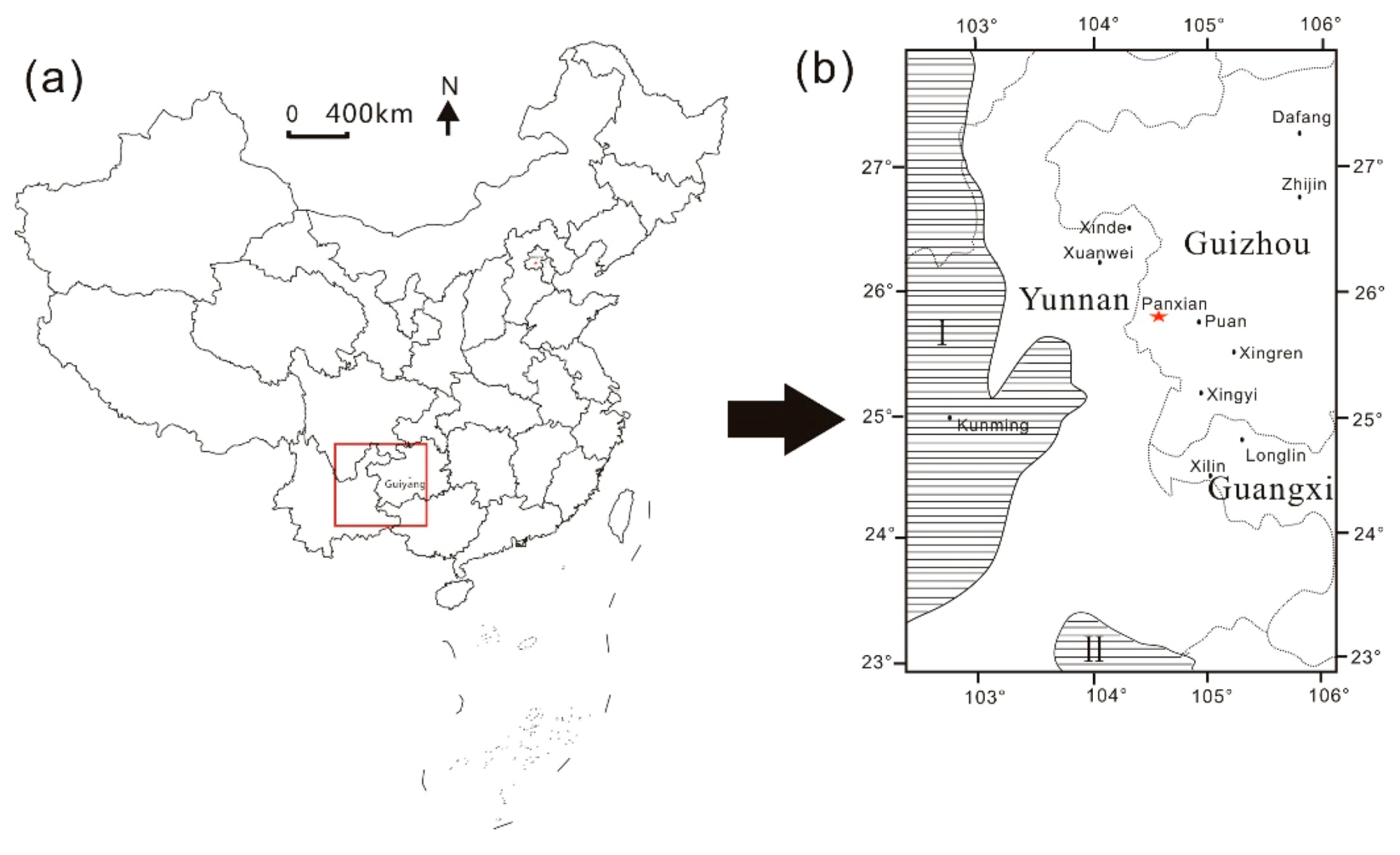
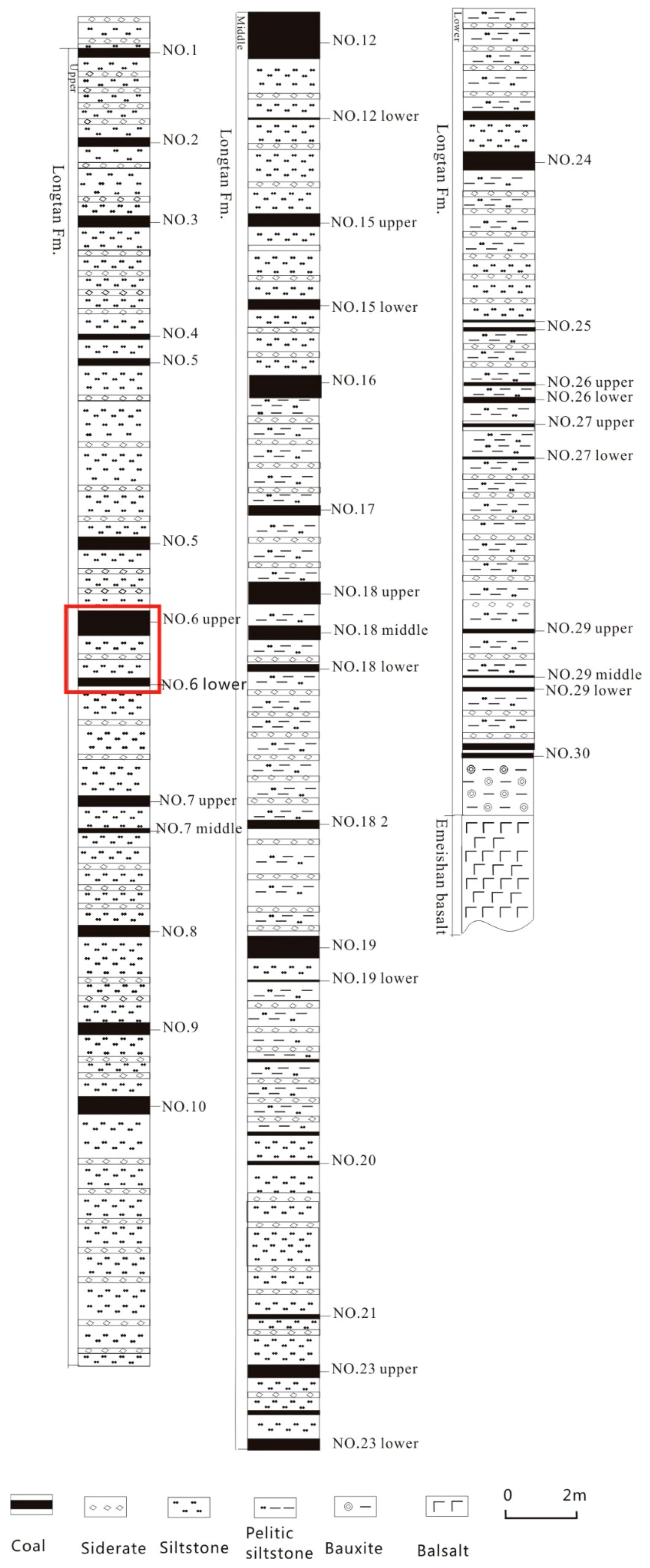
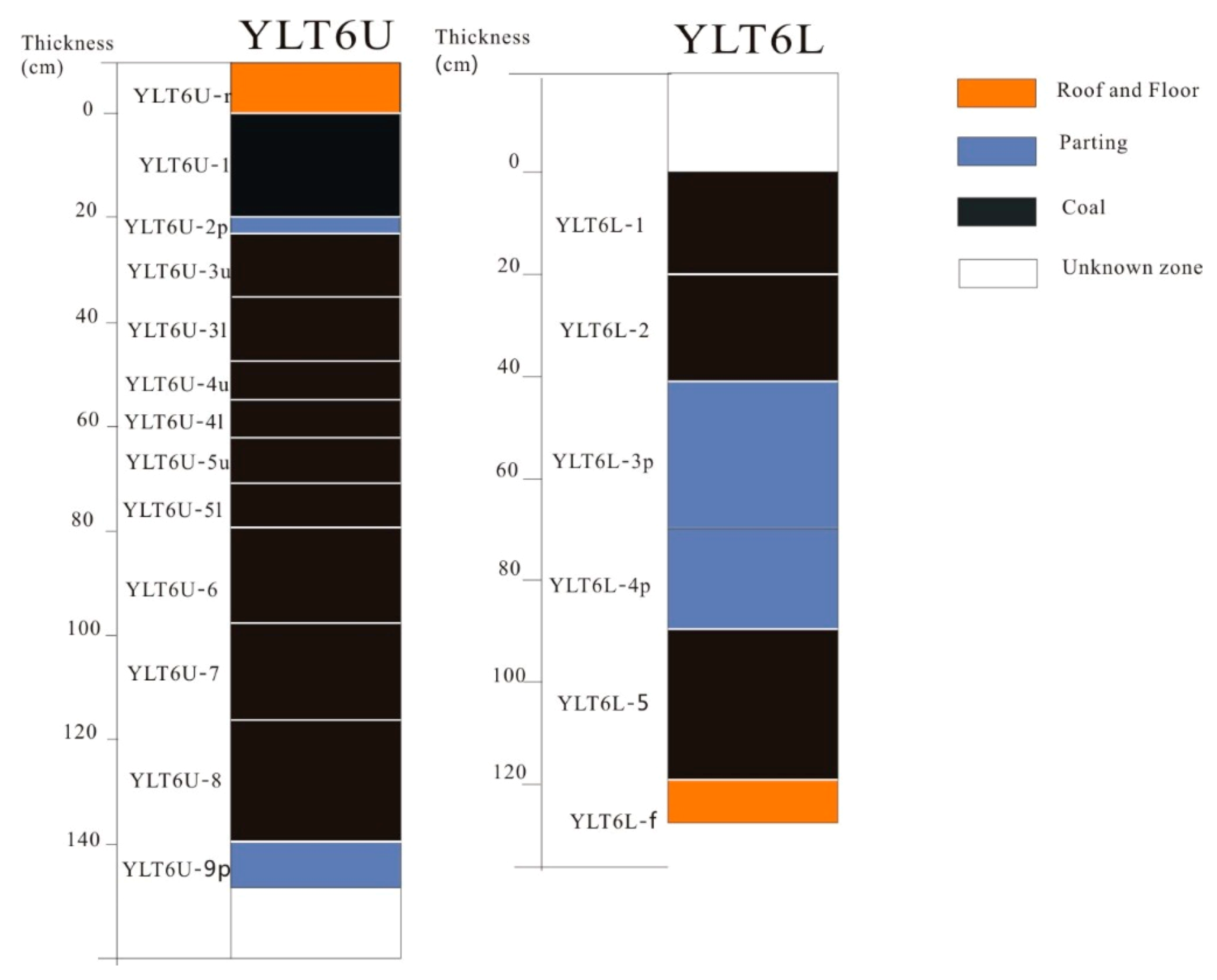
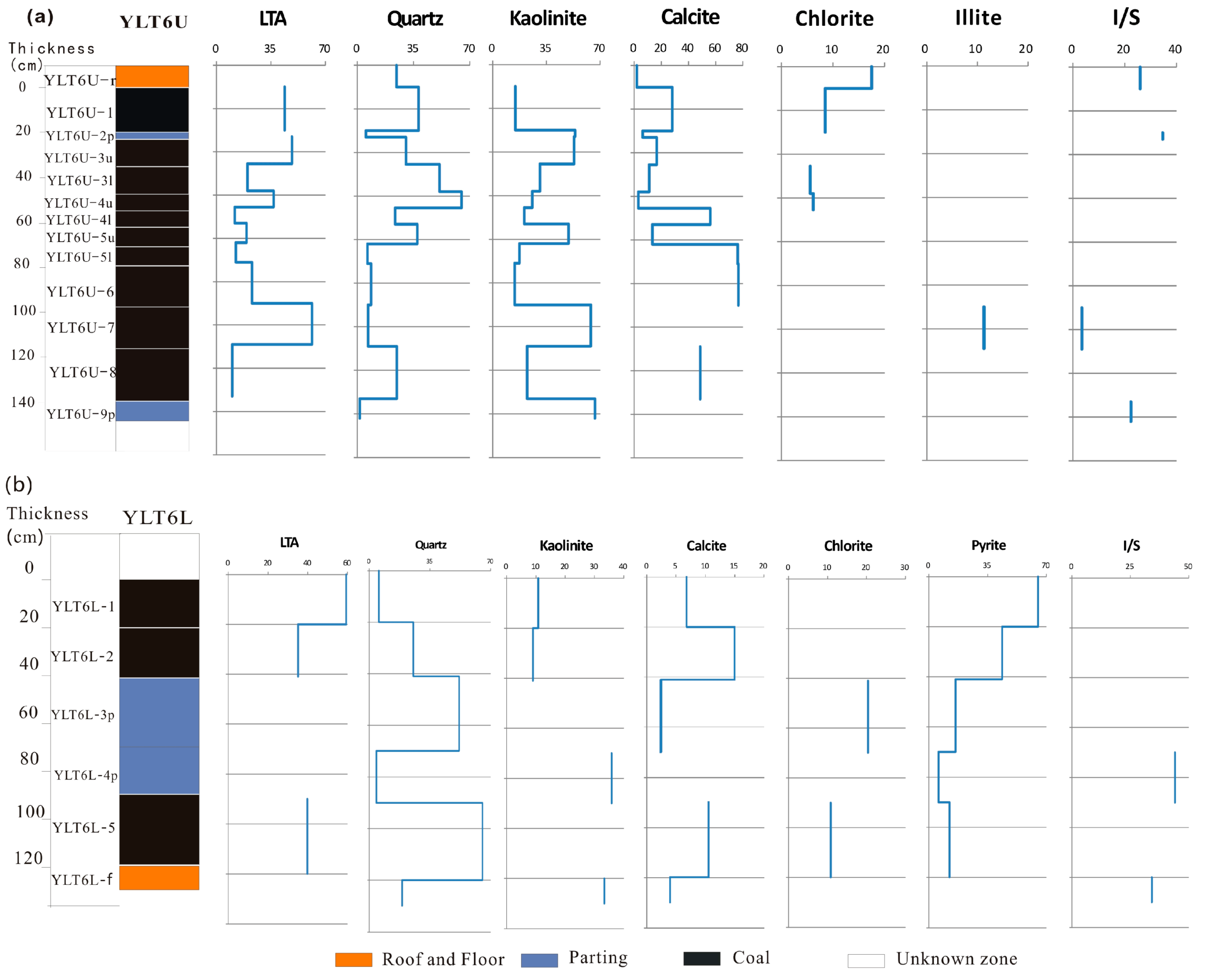
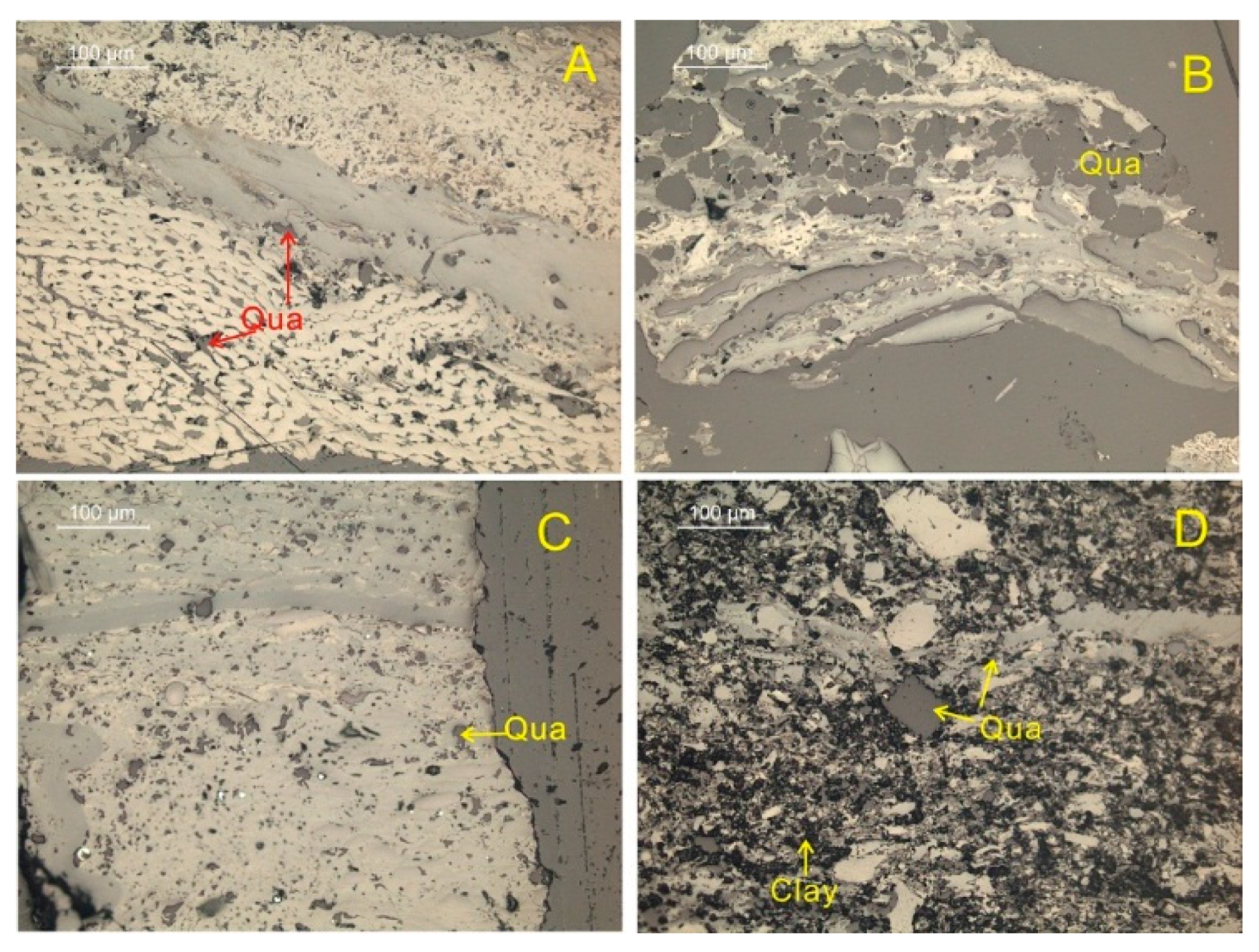
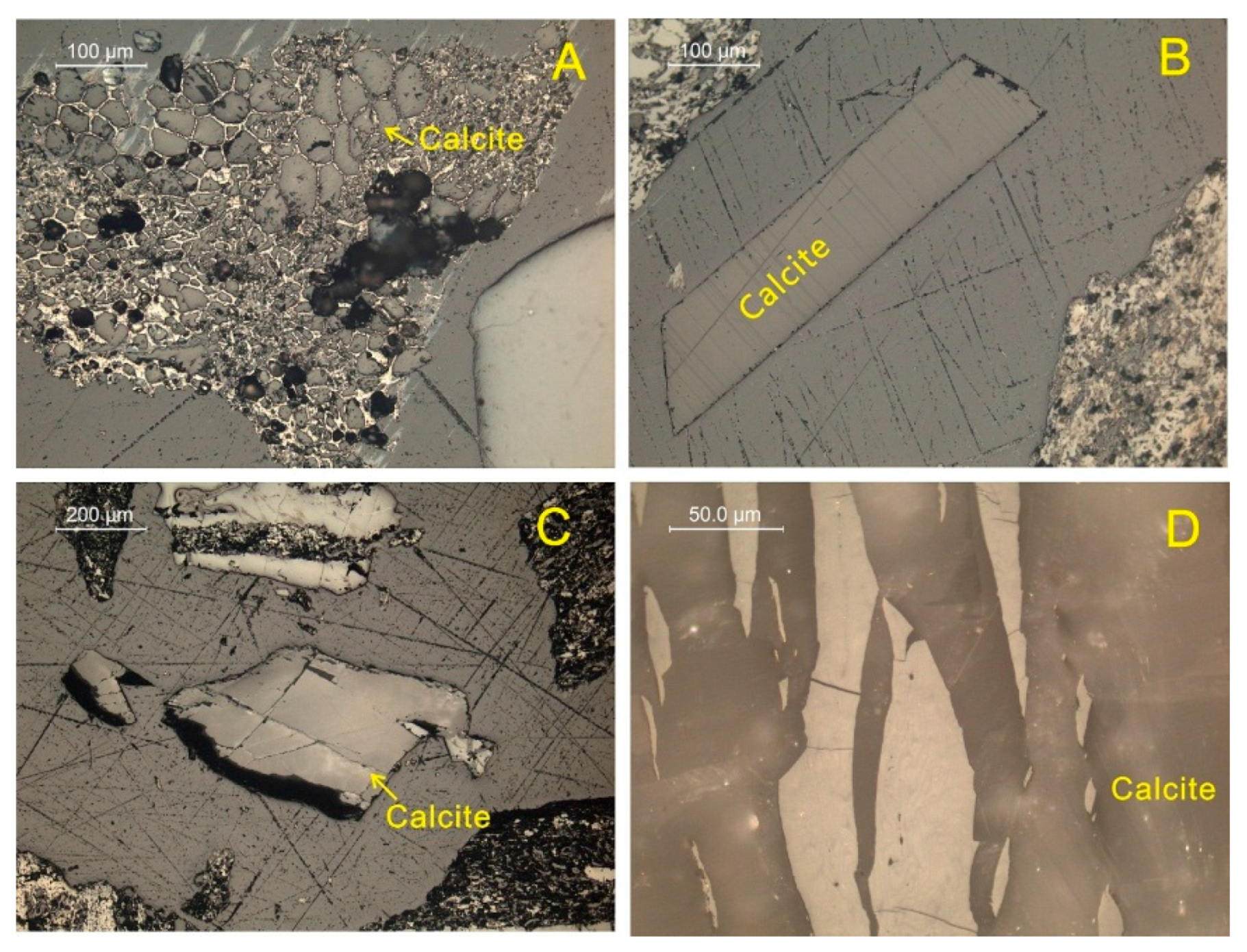
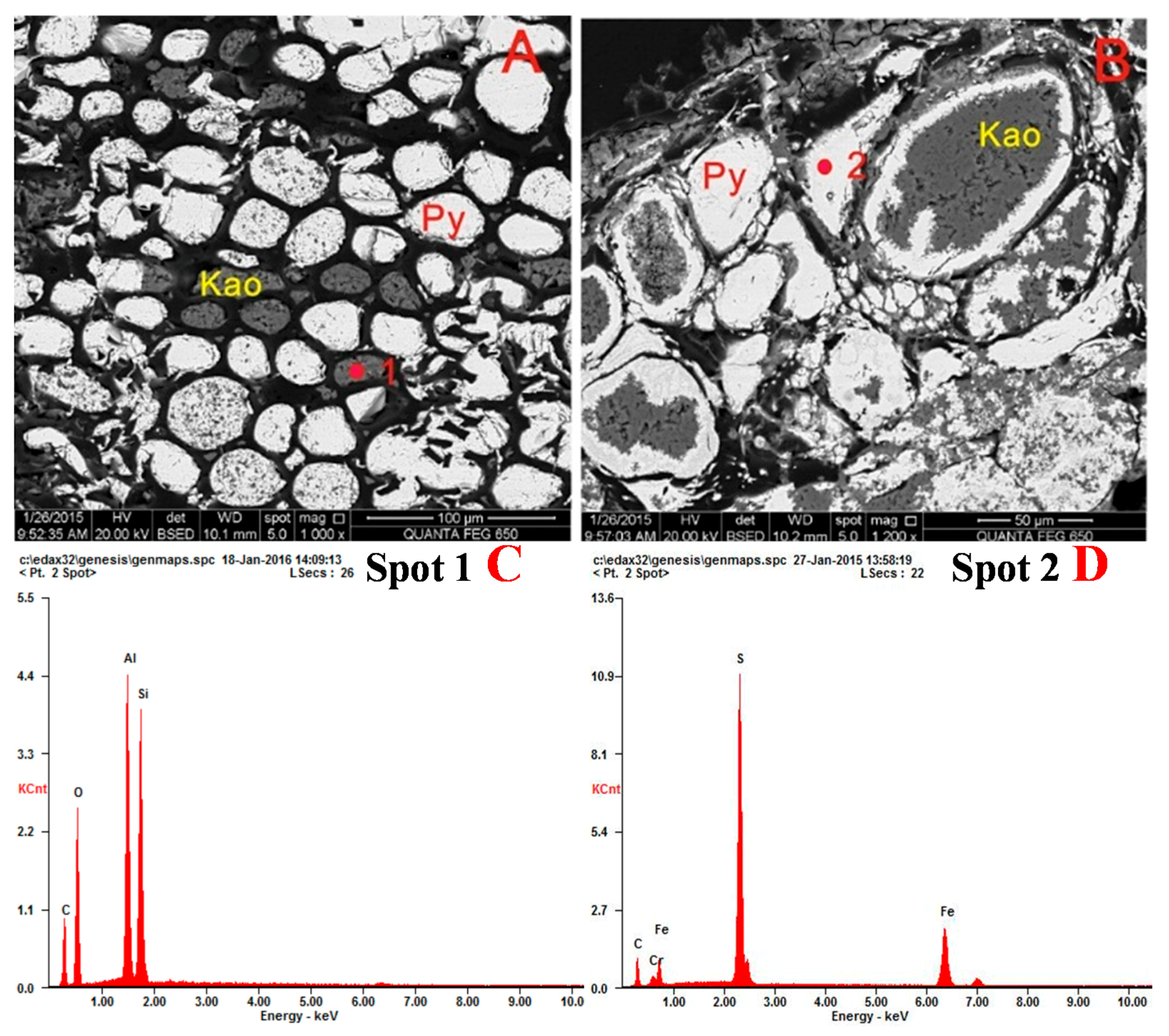
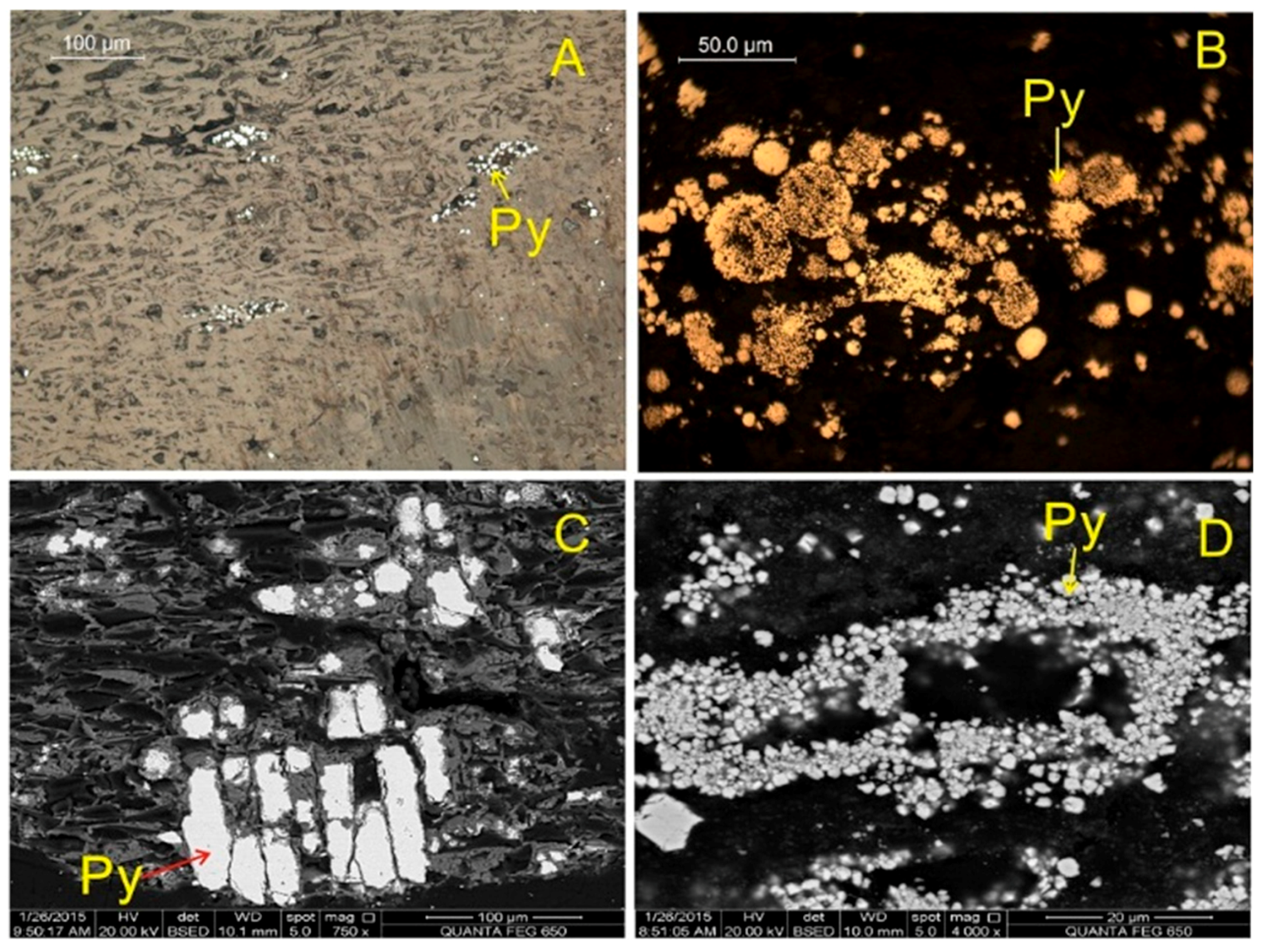


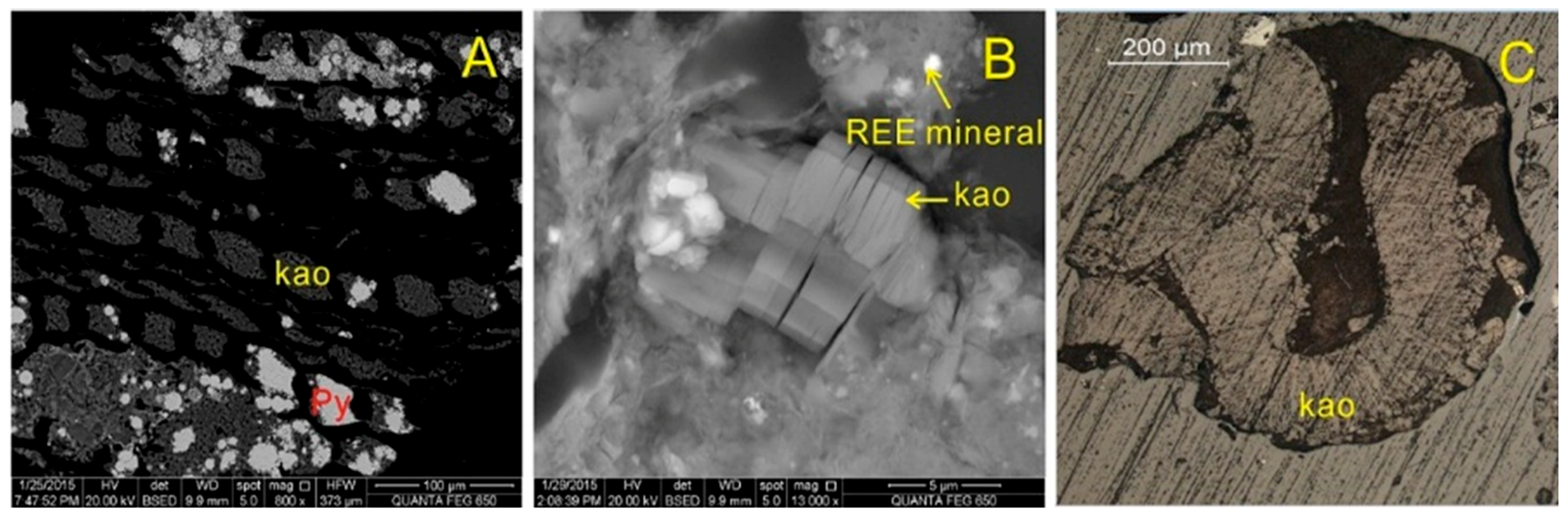
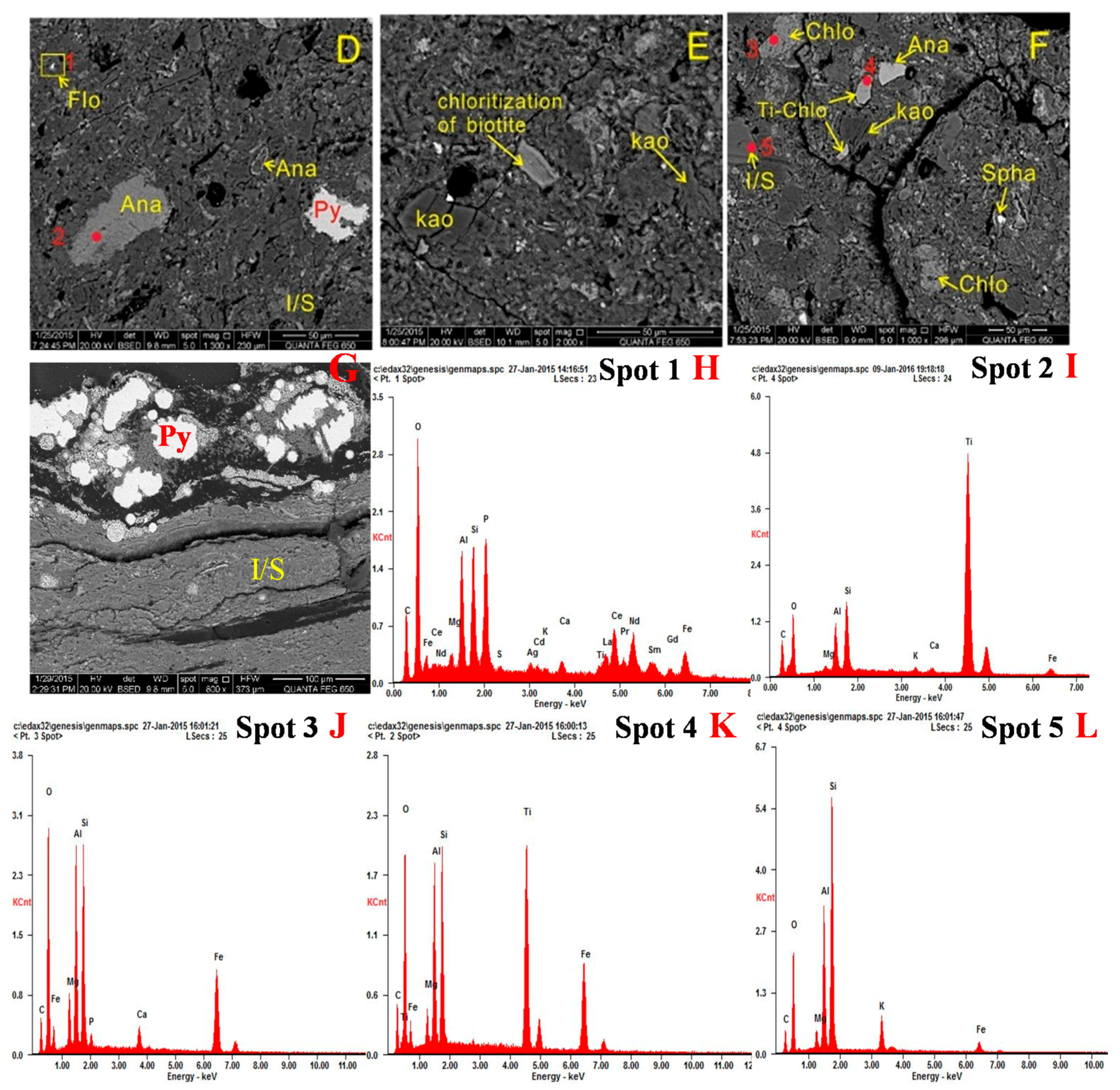
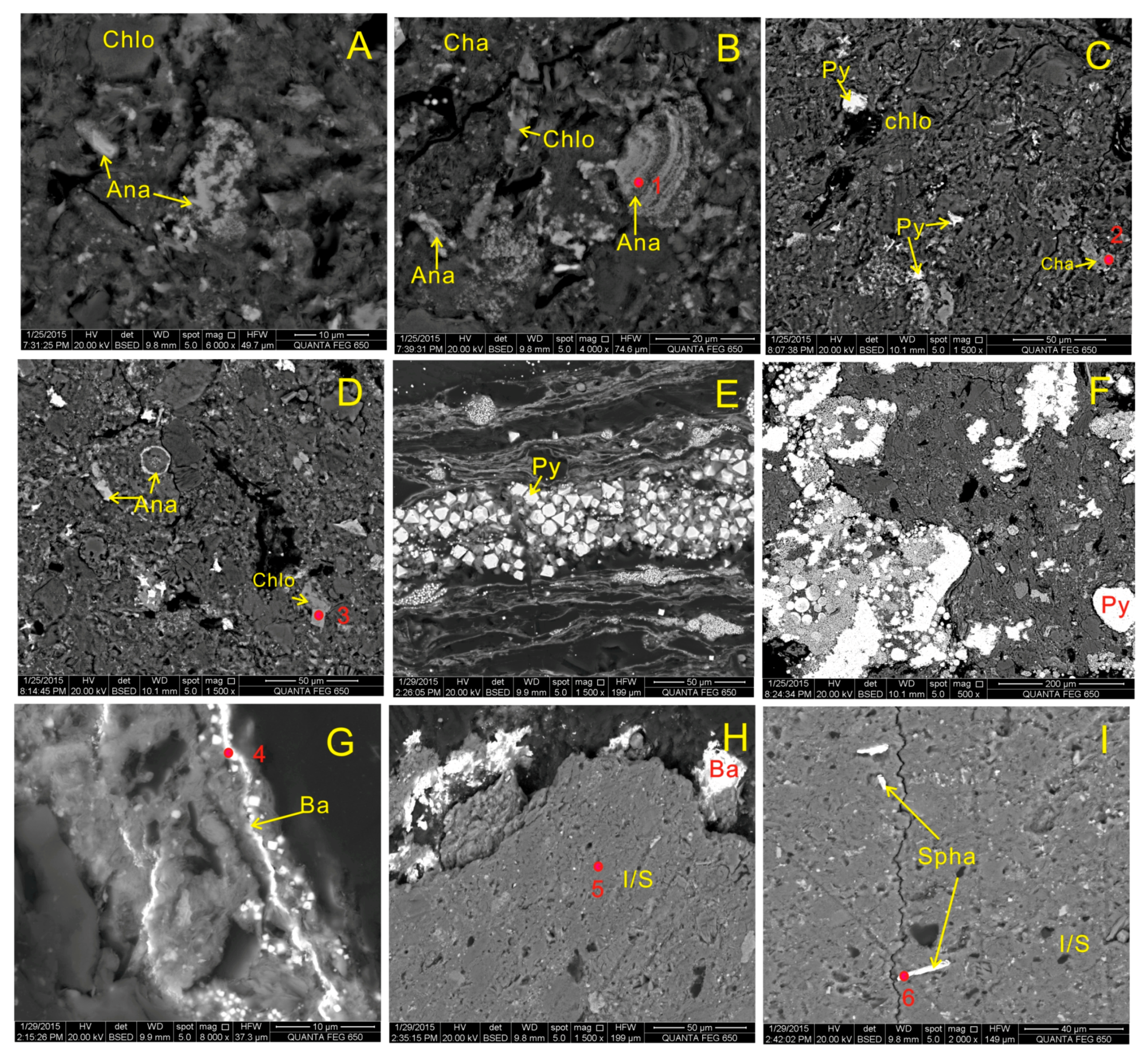
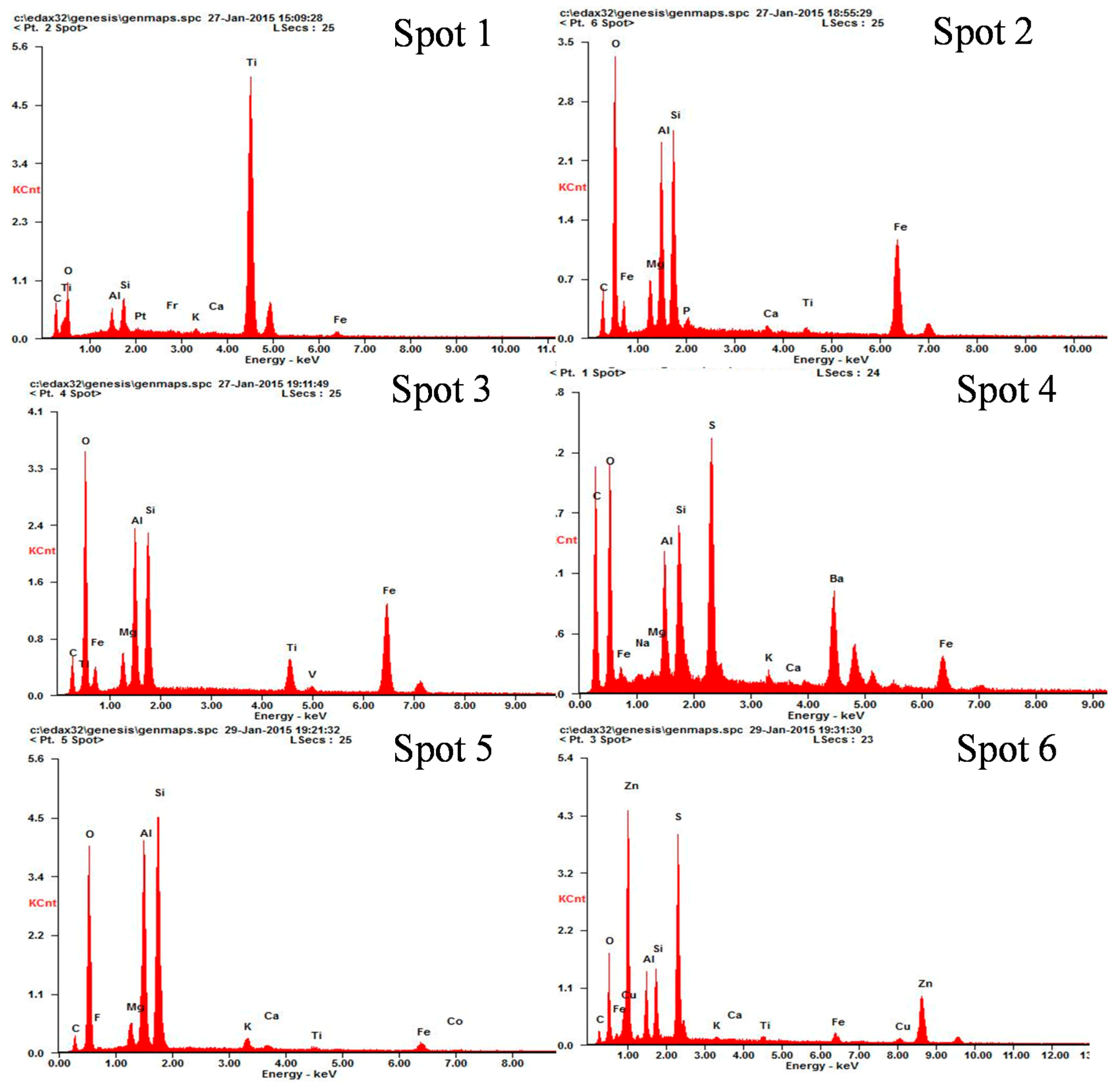

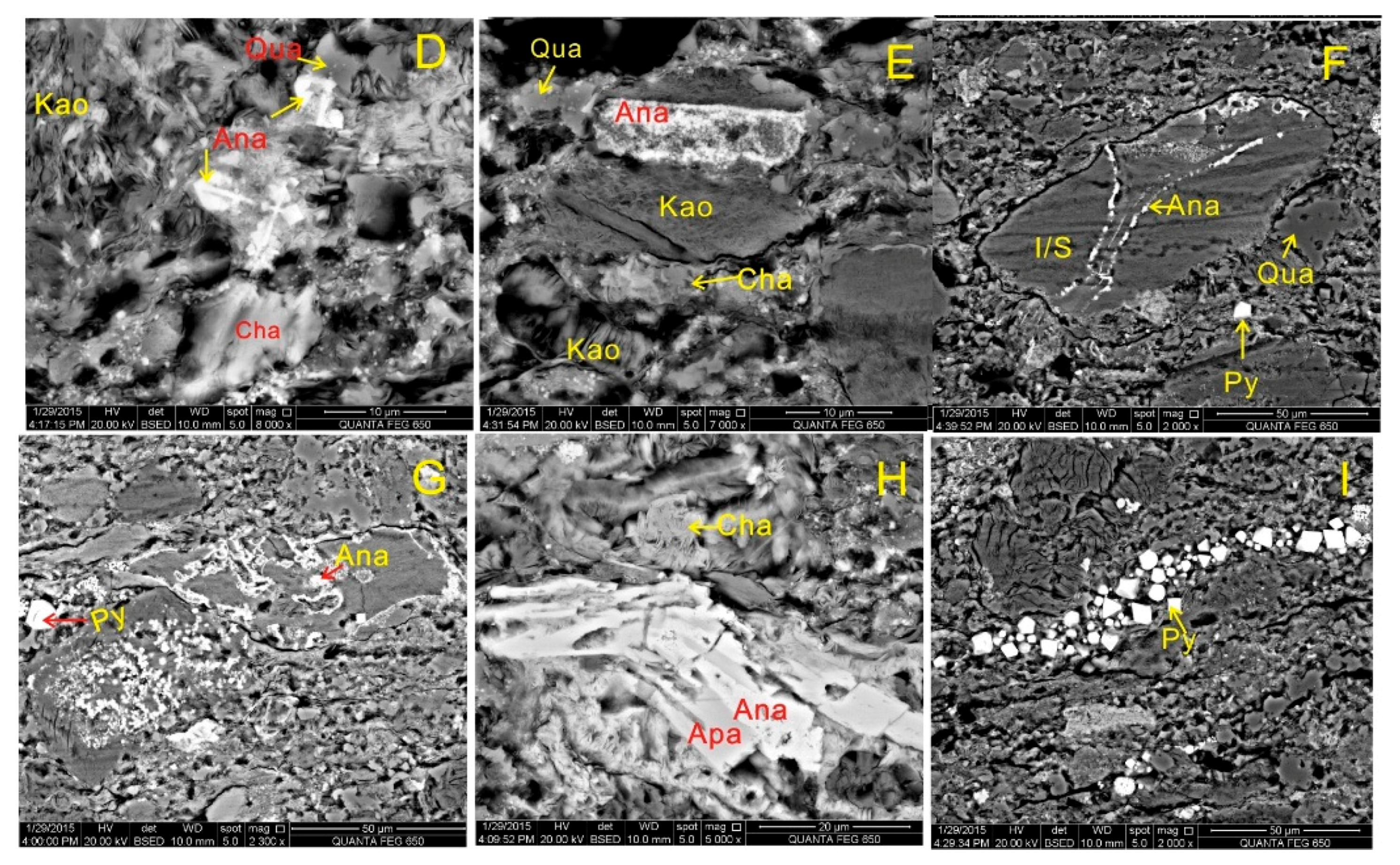
| Sample | Thickness (cm) | Proximate Analyses (%) | Ultimate Analyses (%) | Reflectance | |||||
|---|---|---|---|---|---|---|---|---|---|
| Mad | Ad | Vdaf | St,d | Cdaf | Hdaf | Ndaf | Rr | ||
| YLT6U Coal Seam | |||||||||
| YLT6U-1 | 20 | 0.57 | 36.62 | 41.59 | 0.65 | 83.38 | 5.06 | 1.56 | 1.01 |
| YLT6U-3u | 12.5 | 1.45 | 42.36 | 39.87 | 0.28 | 82.91 | 5.52 | 1.68 | 1.02 |
| YLT6U-3l | 12.5 | 0.72 | 18.71 | 34.63 | 0.61 | 88.37 | 5.35 | 1.76 | 0.95 |
| YLT6U-4u | 7.5 | 0.87 | 34.14 | 34.1 | 0.35 | 87.82 | 7.3 | 1.74 | 0.96 |
| YLT6U-4l | 7.5 | 1.02 | 10.97 | 35.75 | 0.27 | 87.73 | 4.71 | 1.87 | 0.91 |
| YLT6U-5u | 9 | 0.69 | 16 | 35.53 | 0.23 | 86.21 | 4.93 | 1.49 | 0.94 |
| YLT6U-5l | 9 | 0.83 | 10.6 | 36.43 | 0.33 | 86.55 | 4.95 | 1.71 | 0.91 |
| YLT6U-6 | 19 | 0.7 | 19.09 | 36.19 | 0.36 | 86.42 | 4.17 | 1.44 | 0.91 |
| YLT6U-7 | 19 | 0.59 | 26.88 | 37.96 | 0.75 | 92.54 | 4.39 | 1.48 | 0.94 |
| YLT6U-8 | 24 | 0.84 | 10.07 | 36.29 | 0.49 | 87.93 | 4.78 | 1.77 | 0.8 |
| Wa | 140 * | 0.79 | 22.78 | 37.24 | 0.48 | 87.04 | 4.97 | 1.61 | 0.93 |
| YLT6L Coal Seam | |||||||||
| YLT6L-1 | 20 | 0.89 | 40.6 | 44.15 | 13.34 | 58.71 | 5.19 | 1.11 | 0.77 |
| YLT6L-2 | 21 | 1.01 | 27.75 | 37.85 | 8.99 | 80.9 | 4.47 | 1.39 | 0.77 |
| YLT6L-5 | 30 | 0.45 | 36.37 | 35.44 | 3.61 | 86.15 | 4.54 | 1.24 | 0.75 |
| Wa | 71 * | 0.74 | 35.01 | 38.61 | 7.94 | 76.87 | 4.7 | 1.25 | 0.76 |
| Sample | LTA | Quartz | Kaolinite | Chlorite | Illite | I/S | Calcite | Anatase | Pyrite | Bassanite | Ankerite | Rutile | Xenotime | Muscovite | Siderite | Stibnite | Apatite |
|---|---|---|---|---|---|---|---|---|---|---|---|---|---|---|---|---|---|
| YLT6U Coal Seam | |||||||||||||||||
| YLT6U-r | 24.4 | 17.5 | 26 | 1.9 | 6.2 | 12 | 12 | ||||||||||
| YLT6U-1 | 43.8 | 38.1 | 14.8 | 8.5 | 28 | 10.5 | |||||||||||
| YLT6U-2p | 5.4 | 53.7 | 34.7 | 6.2 | |||||||||||||
| YLT6U-3u | 48.49 | 30.3 | 53.1 | 16.6 | |||||||||||||
| YLT6U-3l | 19.95 | 51.2 | 30.8 | 5.6 | 11.1 | 1.3 | |||||||||||
| YLT6U-4u | 36.76 | 64.9 | 25.8 | 6.2 | 3.1 | ||||||||||||
| YLT6U-4l | 11.76 | 23.5 | 20.6 | 56 | |||||||||||||
| YLT6U-5u | 19.35 | 37.3 | 49.4 | 13.4 | |||||||||||||
| YLT6U-5l | 12.46 | 6.3 | 17.4 | 76.3 | |||||||||||||
| YLT6U-6 | 22.89 | 8.6 | 14.3 | 76.8 | 0.3 | ||||||||||||
| YLT6U-7 | 61.43 | 6.7 | 63.9 | 11.3 | 3.5 | 10.7 | 3.9 | ||||||||||
| YLT6U-8 | 10.2 | 24.6 | 22.4 | 48.6 | 4.4 | ||||||||||||
| YLT6U-9p | 1.5 | 66.7 | 22.4 | 9.4 | |||||||||||||
| Wa | 43.82 | 26.6 | 30.8 | 2 | 1.5 | 0.5 | 34.2 | 1.6 | 0.5 | 0.8 | 1.5 | ||||||
| YLT6L Coal Seam | |||||||||||||||||
| YLT6L-1 | 59.35 | 5.6 | 10.8 | 6.8 | 65 | 11.7 | |||||||||||
| YLT6L-2 | 35.11 | 25.4 | 9 | 15 | 43.6 | 4.2 | 1 | 1.7 | |||||||||
| YLT6L-3p | 51.8 | 20.4 | 2.4 | 15.9 | 8.1 | 1.5 | |||||||||||
| YLT6L-4p | 4.1 | 35.9 | 44.1 | 10.1 | 5.8 | ||||||||||||
| YLT6L-5 | 39.79 | 65.3 | 10.8 | 10.5 | 12.3 | 1.1 | |||||||||||
| YLT6L-f | 19 | 33.4 | 34.2 | 3.9 | 8.2 | 1.3 | |||||||||||
| Wa | 43.91 | 36.7 | 5.7 | 4.6 | 10.8 | 36.4 | 1.7 | 3.6 | 0.5 | ||||||||
© 2016 by the authors; licensee MDPI, Basel, Switzerland. This article is an open access article distributed under the terms and conditions of the Creative Commons by Attribution (CC-BY) license (http://creativecommons.org/licenses/by/4.0/).
Share and Cite
Xie, P.; Song, H.; Wei, J.; Li, Q. Mineralogical Characteristics of Late Permian Coals from the Yueliangtian Coal Mine, Guizhou, Southwestern China. Minerals 2016, 6, 29. https://doi.org/10.3390/min6020029
Xie P, Song H, Wei J, Li Q. Mineralogical Characteristics of Late Permian Coals from the Yueliangtian Coal Mine, Guizhou, Southwestern China. Minerals. 2016; 6(2):29. https://doi.org/10.3390/min6020029
Chicago/Turabian StyleXie, Panpan, Hongjian Song, Jianpeng Wei, and Qingqian Li. 2016. "Mineralogical Characteristics of Late Permian Coals from the Yueliangtian Coal Mine, Guizhou, Southwestern China" Minerals 6, no. 2: 29. https://doi.org/10.3390/min6020029
APA StyleXie, P., Song, H., Wei, J., & Li, Q. (2016). Mineralogical Characteristics of Late Permian Coals from the Yueliangtian Coal Mine, Guizhou, Southwestern China. Minerals, 6(2), 29. https://doi.org/10.3390/min6020029





